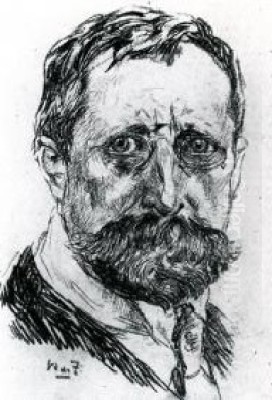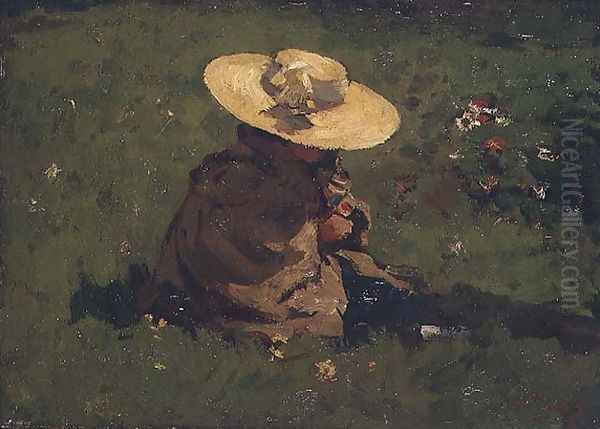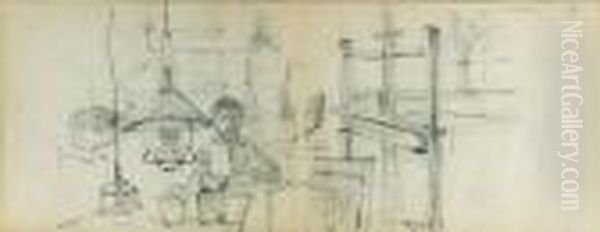
Willem de Zwart stands as a significant figure in Dutch art history, an artist whose work forms a compelling bridge between the atmospheric realism of the Hague School and the vibrant energy of Amsterdam Impressionism. Active during a period of profound artistic change in the Netherlands, De Zwart carved out a unique path, distinguished by his versatile technique, diverse subject matter, and particularly his bold and often unexpectedly bright use of color. Born in The Hague on May 16, 1862, and passing away in the same city on December 11, 1931, his life spanned a crucial era, and his output as a painter, etcher, watercolorist, and even pottery decorator reflects the dynamic spirit of his time.
Early Life and Artistic Awakening in The Hague
Willem de Zwart's origins were rooted in the artisan class of The Hague. He was the eldest of eight children born to a carriage maker. This practical background perhaps instilled in him a sense of craftsmanship that would later inform his art. His younger brother, Pieter de Zwart (1880-1967), would also follow the path of becoming a painter, indicating a shared familial inclination towards the arts. Willem's own artistic interests surfaced early; while initially learning the carriage-making trade from the age of 14, his passion lay elsewhere. He spent his free time diligently copying prints from magazines, honing his observational and drawing skills.
Recognizing his talent and dedication, De Zwart pursued formal art education. In 1877, at the age of fifteen, he enrolled at the prestigious Royal Academy of Art in The Hague. This marked a pivotal step, immersing him in a structured environment where he could develop his technical abilities. His academic training provided a solid foundation upon which he would build his distinctive style.
Tutelage under Jacob Maris and the Hague School Influence

A crucial element in De Zwart's artistic development was his apprenticeship under Jacob Maris, which began around 1877, concurrent with his studies at the Academy. Jacob Maris, along with his brothers Matthijs and Willem Maris, was a leading figure of the Hague School, a movement renowned for its realistic and often moody depictions of Dutch landscapes, coastal scenes, and everyday life. Although Maris had not yet reached the absolute peak of his fame when De Zwart studied with him, his influence was profound. De Zwart is often considered Maris's only formal pupil.
Working in Maris's studio exposed De Zwart directly to the principles and practices of the Hague School. He likely encountered other prominent members of the movement through this connection, absorbing the prevailing artistic currents. The Hague School emphasized atmospheric effects, tonal harmony (often using grays and muted colors), and capturing the specific light and feel of the Dutch environment. Maris reportedly encouraged De Zwart to paint directly onto the canvas, bypassing preliminary sketches on paper, fostering a sense of immediacy and spontaneity in his approach. De Zwart also received guidance from Fridolin Becker during his formative years.
While deeply influenced by the Hague School's naturalism and focus on Dutch themes, De Zwart soon began to distinguish himself. His palette, often incorporating brighter and more intense colors than was typical for the school, set him apart. He absorbed the Hague School's commitment to observation but infused it with a more personal and vigorous expression.
Development of a Distinctive Style: Color and Brushwork
Willem de Zwart's artistic signature lies in his robust technique and individualistic approach. His style is generally characterized as a blend of naturalism and Impressionism. He tackled a wide array of subjects, demonstrating remarkable versatility: landscapes capturing the Dutch countryside, bustling cityscapes reflecting urban life, insightful portraits, and richly textured still lifes. His etchings and watercolors further showcase his command of different mediums.
What truly made De Zwart stand out, particularly within the context of the often more subdued Hague School, was his audacious use of color. He was unafraid to employ vibrant reds, yellows, and blues, creating works with a strong visual impact. This inclination towards brighter hues aligned him more closely with the burgeoning Impressionist sensibilities emerging across Europe, including in the Netherlands itself.
His brushwork was equally distinctive – often bold, vigorous, and applied with confidence. While capable of detailed rendering, he frequently favored a more expressive application of paint, allowing the texture of the brushstrokes to contribute to the overall effect. Some works exhibit a preference for darker, brownish palettes, applied with energetic strokes, while others explode with color. This combination of rigorous observation, strong composition, and expressive technique defined his unique contribution.
The "Hague Breitner" and Connections to Amsterdam Impressionism

De Zwart's powerful style, particularly his dynamic brushwork and interest in capturing the energy of modern life, led to comparisons with his contemporary, George Hendrik Breitner. Breitner was a leading figure of Amsterdam Impressionism, known for his raw, energetic depictions of urban scenes, street life, and working-class subjects. The parallels in their vigorous techniques and sometimes overlapping subject matter earned De Zwart the nickname "the Hague Breitner," acknowledging their shared artistic spirit despite their primary geographical associations (Breitner being more strongly linked with Amsterdam).
De Zwart's connection with Breitner was more than just stylistic similarity. The two artists knew each other, studied alongside each other to some extent, and even traveled together. In 1885, they undertook a trip to the province of Drenthe, a region known for its unspoiled landscapes that attracted many artists. During this trip, they reportedly painted several works on similar themes, suggesting a period of close artistic dialogue and mutual influence.
Although primarily based in The Hague for much of his early career, De Zwart's work increasingly showed affinities with Amsterdam Impressionism. This movement, centered in the rapidly growing capital, focused more on capturing the dynamism and transience of modern urban life, often employing looser, quicker brushwork than the Hague School typically did. De Zwart's cityscapes and depictions of labor, like Working in the Dock, resonate strongly with this sensibility.
Amsterdam Period and Continued Artistic Exploration
Around the year 1900, De Zwart made a significant move, relocating from The Hague to Amsterdam. This placed him directly in the hub of the Amsterdam Impressionist movement. During his time in the capital, which lasted until about 1905, his engagement with urban themes intensified. His works from this period often reflect the faster pace of city life, captured with the quick, loose brushstrokes characteristic of Amsterdam Impressionism.
While in Amsterdam, De Zwart maintained contact with fellow artists. Notably, he frequently interacted with Willem Witsen, another important figure associated with Amsterdam Impressionism and the Tachtigers literary movement. Witsen, known for his atmospheric etchings and paintings of Amsterdam, likely shared artistic interests and perspectives with De Zwart. This period further solidified De Zwart's connection to the more progressive artistic trends developing in the Netherlands at the turn of the century.
His time in Amsterdam allowed him to explore new subjects and refine his impressionistic techniques, focusing on capturing fleeting moments and the interplay of light in the urban environment. This phase added another layer to his already diverse oeuvre, showcasing his adaptability and ongoing artistic curiosity.
Versatility Across Mediums
Willem de Zwart was not confined solely to oil painting. His artistic practice was notably diverse, encompassing several mediums with considerable skill. He was an accomplished etcher, producing prints that demonstrate his strong draughtsmanship and ability to convey texture and atmosphere in monochrome. Etching allowed him to explore line and tone in a different manner, often focusing on similar subjects as his paintings, such as landscapes and urban vignettes.
Watercolor was another medium in which De Zwart excelled. His watercolors often possess a luminosity and immediacy suited to capturing fleeting effects of light and weather. Works like Working in the Dock demonstrate his ability to use watercolor with both precision and expressive freedom, employing vibrant color washes alongside defined lines.
Furthermore, De Zwart engaged in pottery painting, decorating ceramics. This aspect of his work is less commonly highlighted but speaks to his broad artistic interests and his connection to applied arts, perhaps echoing his father's background in craftsmanship. This versatility across oil painting, etching, watercolor, and pottery decoration underscores his comprehensive engagement with the visual arts.
Representative Works and Themes
Several key works exemplify Willem de Zwart's style and thematic concerns. His Still Life with Apples in a Delft Blue Bowl (or similar titles, housed in the Rijksmuseum, Amsterdam) showcases his skill in still life painting. Such works often combine rich textures, strong compositions, and his characteristic use of color – in this case, likely contrasting the vibrant fruit with the iconic blue and white ceramic. These still lifes demonstrate his ability to find artistic interest in everyday objects, imbuing them with presence and vitality.
Working in the Dock, a watercolor, is significant not only for its technical execution but also for its subject matter. Depicting laborers at work, it reflects an interest in modern industrial life, a theme explored by artists associated with the Tachtigers movement. This movement, encompassing both literature and art in the 1880s and 90s, often engaged with social realism and the impact of rapid industrialization on Dutch society. The work's vibrant color and dynamic composition capture the energy and grit of the scene.
Paintings like Girl in the Grass likely represent his engagement with Impressionist themes, focusing on figures in landscapes, the play of sunlight, and capturing a sense of leisure or everyday life outdoors. His period in Veur yielded numerous pastoral scenes, such as Milking time in a summer landscape, depicting cows grazing or being milked. These works often feature the lush greens and atmospheric light of the Dutch countryside, treated with his characteristic blend of realism and painterly brushwork. The illustration simply titled Girl, available as prints, points to his work potentially extending into graphic arts or book illustration as well.
Network of Contemporaries and Artistic Dialogue
De Zwart operated within a rich network of contemporary artists, engaging in relationships that ranged from mentorship to collaboration and friendship. His primary teacher, Jacob Maris, provided a foundational link to the Hague School establishment. His contemporary, George Hendrik Breitner, served as both a peer and a point of comparison, their shared trip to Drenthe highlighting a period of direct artistic exchange.
In the mid-1880s, De Zwart also established connections with Jan Toorop and Charles Dankemeijer. Toorop, known for his later Symbolist work, was exploring various styles during this period, and their interaction suggests De Zwart was part of the broader artistic discussions happening in The Hague. These connections placed him within the evolving landscape of late 19th-century Dutch art.
His move to Amsterdam brought him into closer contact with figures like Willem Witsen. The relationship between his brother, Pieter de Zwart, and the painter Willem Carelken also indirectly connects to Willem de Zwart's circle; Carelken reportedly sold the elder De Zwart's work to help fund Pieter's artistic pursuits, indicating a supportive network. Other major figures of the time whose work provides context for De Zwart include Hague School masters like Anton Mauve, Jozef Israëls, and Hendrik Willem Mesdag, as well as Amsterdam Impressionists like Isaac Israëls (son of Jozef). De Zwart navigated these various influences and relationships, forging his own path.
Teaching, Later Life, and Challenges
Later in his career, Willem de Zwart also dedicated time to teaching, passing on his knowledge and experience to a new generation of artists. He taught at the Hague Academy of Art, the same institution where he had received his own training. Among his notable students were Herman Bogman Jr., Herman Heuff, Cor Nolte, and Martinus van Regteren Altena. His role as an educator further cemented his position within the Dutch art world.
His personal life, however, faced challenges. For health reasons, he spent a period (from 1894 to 1900) living in Veur, near Leidschendam, before his move to Amsterdam. It was during this time that he produced many of his tranquil pastoral landscapes featuring cattle. After his Amsterdam period, he eventually returned to The Hague in 1917.
Sources indicate that his later years were marked by difficulties. He reportedly lived in shelters for a time and suffered from periods of "mental distress." Tragically, this distress apparently led him to destroy some of his own works. Despite these personal struggles, he continued to be recognized for his artistic contributions and maintained his teaching activities when possible. He passed away in The Hague in 1931 at the age of 69.
Legacy and Recognition
Willem de Zwart is recognized today as an important transitional figure in Dutch art. He successfully navigated the shift from the established realism of the Hague School towards the more modern sensibilities of Impressionism, particularly the Dutch variant centered in Amsterdam. His ability to blend the atmospheric depth of the former with the vibrant energy and looser technique of the latter resulted in a unique and powerful body of work.
Throughout his career, De Zwart received accolades and exhibited his work widely in venues in The Hague, Amsterdam, and potentially internationally, gaining recognition from critics and collectors. His nickname, "the Hague Breitner," while perhaps simplifying the nuances of his style, underscores his perceived importance and connection to the dynamic forces reshaping Dutch art at the time.
His paintings, etchings, and watercolors are held in major Dutch museum collections, including the Rijksmuseum in Amsterdam and the Kunstmuseum Den Haag, ensuring their accessibility to the public. Art historians consider him a key representative of late Hague School painting and Dutch Post-Impressionism. His work continues to be appreciated for its technical skill, bold use of color, and evocative depictions of Dutch life and landscape.
Conclusion: An Enduring Contribution
Willem de Zwart remains a compelling figure in the narrative of Dutch art around the turn of the 20th century. Emerging from the heart of the Hague School under the tutelage of Jacob Maris, he absorbed its lessons of naturalism and atmospheric rendering but refused to be confined by its conventions. His embrace of brighter colors, vigorous brushwork, and diverse subject matter—ranging from tranquil pastures and intimate still lifes to energetic city scenes and depictions of labor—marked him as an individualist. His connections to both The Hague and Amsterdam, and his stylistic affinities with figures like Breitner, place him at a fascinating intersection of artistic movements. Despite personal hardships later in life, his prolific output and role as an educator secured his lasting influence. Willem de Zwart's art continues to resonate through its vitality, its skillful execution, and its unique synthesis of tradition and burgeoning modernity in Dutch painting.